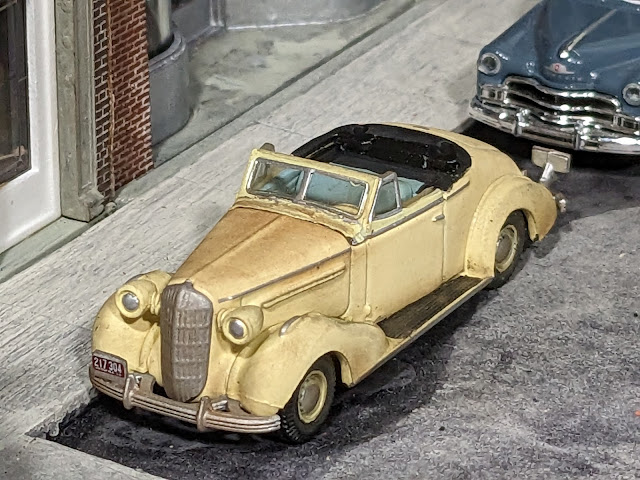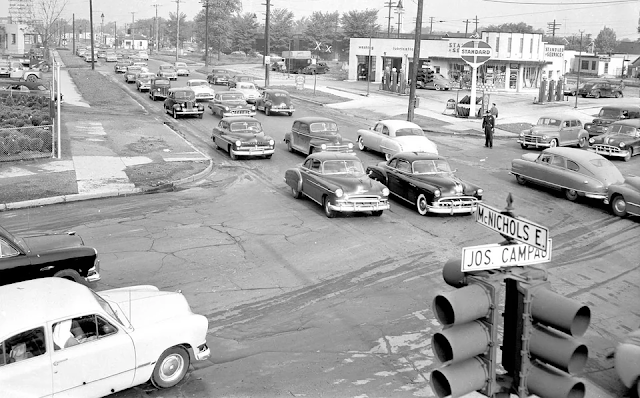Those of us modeling the 50s are blessed these days with a variety of excellent scale model automobiles fitting the period. On the SNR though, it's only 1952, so most of the car "fleet" should be from the 40's, with their pointy snoots and pontoon fenders - and that's an under-represented class in HO. Also under-represented are mundane Ford, Plymouth, and Chevrolet sedans, in favor of the rarer, classier models, which stand out a bit too much for a "fleet" look. Sylvan makes quite a range of 40's cars, but those are Lexan kits - expensive and a lot of work. Someday...
So to fill out the fleet with older cars, I needed to reach back into the '30s. Oxford Diecast of the U.K. offers a very nice 1936 Buick which is a good add, even if it's a convertible - but by '52 it would be 16 years old - an automotive Methuselah at the time. It would be at best a $75 car, assuming it hadn't already been declared terminal for needing rings and a valve job. Those beautiful Oxford cars were going to need some "facelifting", and "downscaling", to fit Truman-era Appalachia.
- Dual side-mounts. Who are we, Roosevelts? Only the fanciest cars would have carried them in the first place. And after 16 years, certainly most would have been discarded as being in the way. Granted, with a rumble seat there was no trunk to put a spare in, but most coupes and roadsters carried one on the rear bumper. Putting on airs with fancy covered tires, gracious sakes - thankfully they were not cast-on, and could be pulled away. I painted the hollows black on the maroon car, and tried to match the body color on the yellow car.
- Whitewalls. Until the mid-50's, these were another extravagance that you'd only find on newer luxury cars. Very few people buying a used car, or a new car from the "low-priced field", would have coughed up the extra five bucks for wide whites. Yet every over-restored, option-laden, too-shiny rig at a "Boomer Car Show" these days, like most every HO model, is sporting gleaming sneakers like Spike Lee. Look at period pictures - most everyone's on blackwalls. See below.
- Black grille. Huh? For some reason, the yellow car came with its grille and cowl painted black. I'd never seen this before, and could not find an example on Google. So I returned the grille to silver, and hit the cowl with body color.
- Top boot. In the history of convertiblism, no one has ever put the cover on over any folded top, except for parades and first dates. They are an enormous pain. Even with my '62 Caddy, I only put the boot on for the first car show of the season - then once I need to put the top up, it's back into the trunk again until next April.
- Top well. Without the boot though, I needed to do something to simulate the top folded down into the well. So I filled the mounting holes with putty, and painted the edges flat black to simulate the canvas top where it attaches to the body. I painted the center a grayish-black to simulate the top's interior as seen when folded, then outlined some of the edge shapes in glossy black, to represent the top's header bow and side rails. It's no contest winner, but it does go a long way toward suggesting a workaday old convertible from a distance.
- Paint. Until Messrs. Ditzler and Dupont graced us with acrylic enamels and clearcoat lacquers, automotive paint was just not that good. It was not terrifically shiny right out of the booth, and until the mid-50's, waxing was almost unheard of, unless your chauffeur needed something to fill his downtime with. So being unprotected, the paint just oxidized away down to the primer. As I try to do with any model auto more than 4 years old, I painted both cars with Dullcote to kill the gloss. And since they're so old, I also added surface rust on the horizontals using pastels - particularly on the hoods, because of the engine heat helping the process along.
- Dirt. You know what else wasn't that good? Roads. Most country roads were still dirt in the '50s, or maybe paved with gravel or cinders if you were lucky. Most folks didn't wash their cars much either, since they'd get dirty so quickly on those roads - so rural cars got pulled into a downward spiral of dullness and filth. Shiny cars were for city folk! So I added a general coating of dirt, particularly on the fenders and wheels, and ground in 16 years' worth of use into the drivers' seats as well. The dirt and rust also served to dim down the cream yellow, to more of a proper background level.
Another of my "someday" jobs will be to make a pass through the whole automobile fleet, and apply these considerations across the board for a coordinated look, as we do with the freight car fleet. Here's a good target shot for that fleet look, from Detroit in what looks to be 1951.
What are some of the things this photo tells us about the street "scene" in that period?
- Very few cars are shiny
- Very few cars are even clean - even in a city on paved streets
- Very few cars are on whitewalls
- Very few cars have full wheelcovers, rather than just hubcaps
- Very few cars are luxury cars, or even from the "mid-priced field"
- Very few cars are not a dark color
- Very few cars are pre-war
And in any case, thanks for reading, and let's hear what you think in the comments!
** OK what gems does this feast for the eyes hold?
- The newest car I can make out is the '50 Chevy front & center. The one back in traffic might be a '51.
- The second-oldest car I can see is the '39 LaSalle back in traffic. Interestingly it also is one of the cleanest - might well be a chauffeured car. Old money has no problem with old things.
- The oldest car is the beater '35 Ford behind the LaSalle. Virtually everything else on the street is post-war - at most, six model-years old.
- Is the Hudson getting a push? Or is the guy behind him just that impatient! Any further up his pipe and the guy could see daylight through the grille. Same with the poor Studebaker 3 cars ahead.
- Hey look - a black '49 Mercury coupe that hasn't gotten the James Dean chop & slam job yet! Rebel Without a Cause is still 4 years off - but in the 21st century, there are nearly no stock ones left.
- Check out Mr. Car-Proud in the black '50 Pontiac coupe! He's got a glistening Simoniz job going, along with gleaming wide-whites. Totally out-sparkles the equally new car next to him.
- In the absence of any new Cadillacs, the light-colored '49 Olds wins the technology prize, boasting the only OHV V-8 in the whole shot. The LaSalle and the Fords & Mercs have V-8s, of course, but they're flatheads. (The engines!)
- Man I love this stuff. Hey, where are the pavement markings?!






